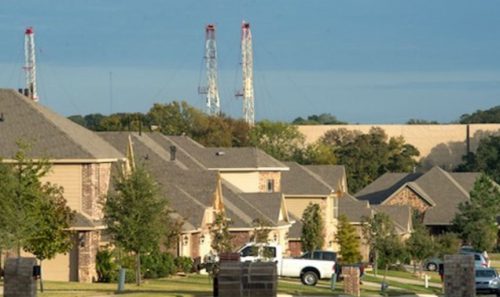Researchers have discovered a possible connection between cardiovascular disease and the intensity of oil and gas exploration. The scientists, from Colorado School of Public Health and National Jewish Health, wrote about their study and findings in the journal Environmental Research (citation below).
They carried out a pilot study involving 97 men and women in Windsor, Greeley, and Fort Collins. They found that people living near areas with more intense oil and gas development showed early signs of cardiovascular disease. Signs included changes in the stiffness of blood vessels and higher blood pressure. Both those signs are markers of inflammation.
Lead author Lisa McKenzie said:
“We are not sure whether the responsible factor is noise or emissions from the well pads or something else, but we did observe that with more intense oil and gas activity around a person’s home, cardiovascular disease indicator levels increased.”
McKenzie is an Assistant Research Professor at the Colorado School of Public Health at the University of Colorado Anschutz Medical Campus.

Measuring indicators of cardiovascular disease
The researchers measured indicators of cardiovascular disease in 97 men and women from October 2015 to May 2016. None of them smoked – neither tobacco nor marijuana.
The participants didn’t have jobs that exposed them to solvents, fumes, dust, or oil or gas development activities.
None of the participants had histories of chronic inflammatory disease like asthma or arthritis, or chronic obstructive pulmonary disease. Neither did any of them have a history of diabetes.
In the United States, cardiovascular disease caused more than 900,000 deaths in 2016. It is the leading cause of mortality in the country.
The authors wrote:
“While behavioral and genetic factors contribute to the burden of CVD, exposure to environmental stressors, such as air pollution, noise and psychosocial stress also contribute to cardiovascular morbidity and mortality.”
The extraction of oil and gas in residential areas is one increasingly common source of these stressors.
Advances in micro-seismic imaging, horizontal drilling, and fracking have made many new areas explorable today. Those areas were inaccessible before. Some of these wells today are in densely-populated areas.
Prof. McKenzie said:
“More than 17.4 million people in the U.S. now live within one mile of an active oil and gas well.”
Exposure to particulate matter and cardiovascular disease risk
Prior studies have demonstrated that short-term and long-term exposure to some kinds of particulate matter may be linked to increases in cardiovascular disease and death. Specifically, the type of particulate matter emitted from oil and gas operations.
Furthermore, noise levels close to these facilities have exceeded levels associated with higher cardiovascular disease and hypertension risk. Hypertension means high blood pressure.
This latest study was the first to try to determine whether there was a relationship between cardiovascular disease and oil and gas development.
In a press release, the University of Colorado Anschutz Medical Campus wrote:
“This study is the first to investigate the relationship between oil and gas development and CVD. But the results are consistent with an increase in the frequency of cardiology inpatient hospital admissions in areas of oil and gas activity in Pennsylvania.”
Prof. McKenzie said:
“Our study findings support the use of these indicators of cardiovascular disease in future studies on oil and gas development in residential areas.”
Those indicators include arterial stiffening, blood pressure, and early markers of inflammation.
Need for a much larger study
This was only a pilot study, Prof. McKenzie acknowledged. A pilot study is a small-scale study which helps determine whether a larger study should follow. The researchers say that their findings demonstrate the need for a much larger study.
Citation
“Relationships between Indicators of Cardiovascular Disease and Intensity of Oil and Natural Gas Activity in Northeastern Colorado,” James Crooks, Lisa M.McKenzie, Jennifer L. Peel, Stephen Brindley, Benjamin D.Blair, William B.Allshouse, John L.Adgate, and Stephanie Malin. Environmental Research, 6 December, 2018. DOI: https://doi.org/10.1016/j.envres.2018.12.004.

